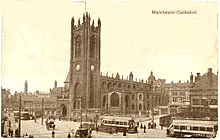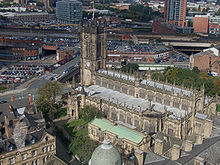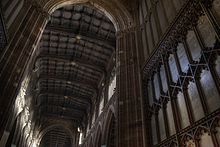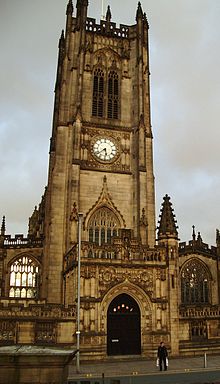- Manchester Cathedral
-
Manchester Cathedral 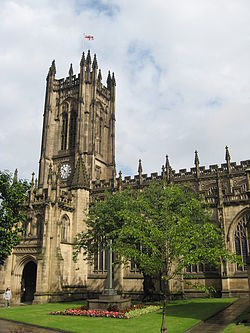
Shown within Greater Manchester 53°29′07″N 2°14′41″W / 53.48528°N 2.24472°WCoordinates: 53°29′07″N 2°14′41″W / 53.48528°N 2.24472°W Location Manchester, Greater Manchester Country England Denomination Church of England Website www.manchestercathedral.org Architecture Style Gothic (Perpendicular) Years built 1421–1882 Administration Diocese Manchester (since 1847) Province York Clergy Dean Rogers Morgan Govender Manchester Cathedral is a medieval church on Victoria Street in central Manchester and is the seat of the Bishop of Manchester. The cathedral's official name is The Cathedral and Collegiate Church of St Mary, St Denys and St George in Manchester. It has also variously been known locally as St Mary's, Christ Church and, simply, t'owd church.[citation needed][1]
Although extensively refaced, restored and extended in the Victorian period, and then again following severe bomb damage in the 20th century, the main body of the Cathedral largely derives from the wardenship of James Stanley (warden 1485–1506), and is in the Perpendicular Gothic style. Stanley was also primarily responsible for commissioning the spectacular late medieval wooden furnishings, including the pulpitum, the choir stalls, and the nave roof supported by angels with gilded instruments. It is one of the Grade I listed buildings in Manchester. Since 2005 the Dean of the Cathedral has been the Very Reverend Rogers Morgan Govender.[2]
Services are currently held on Mondays to Fridays at 9:00 am (Morning Prayer), 1:10 pm (Holy Communion), and 5:30 pm (Evensong); on Saturdays at 9:00 am (Morning Prayer), 9:15 am (Holy Communion), and 3:30 pm (Evensong); and on Sundays at 8:45 am (Morning Prayer), 9:00 am (Holy Communion), 10:30 am (Sung Eucharist) and 5:30 pm (Evensong).
Contents
History and furniture
The Middle Ages
A church dedicated to St Mary is recorded in the Domesday Survey, although the only surviving evidence from this period is a small carving of an angel with a scroll, preserved in the Cathedral nave; the Old English inscription on the stone translates as "into thy hands, O Lord, I commend my spirit".[3][notes 1] The Domesday Book entry for Manchester reads "the Church of St Mary and the Church of St Michael hold one carucate of land in Manchester exempt from all customary dues except tax".[5][notes 2]
Construction of the predecessor church started in 1215 within the confines of the Baron's Court beside the manor house on the site of Manchester Castle. The occupying lords of the manor were the Grelley family, and their coat of arms is still associated with the cathedral to this day. The Grelley family acted as stewards of the church, building and endowing the first chancery, the St. Nicholas Chancery.
In 1311, for lack of Grelley heirs, the estate passed by marriage to the de la Warre family. The 14th century west tower and eastern Lady Chapel of this building were to be incorporated into the current structure (although little or no fabric of that date is still visible). In 1349 the St. Nicholas Chancery was endowed by the de Trafford family. The involvement of the de la Warre family was furthered in 1382 when Thomas de la Warre, later to be appointed Baron of Manchester, became rector of the parish church.
In 1421, Thomas de la Warre obtained a licence from King Henry V and from Pope Martin V to establish a collegiate foundation in Manchester, appropriating the parish church for the purpose. The college was established in 1422 by royal charter, with a warden, eight fellows, four singing clerks and eight choristers, an exceptionally large foundation charged with the duty of praying for the souls of those killed in the king's campaigns in France. The priests of the college were housed in collegiate buildings to the north of the church, built on the site of the former manor house. The buildings survive as Chetham's Hospital school and library, founded in 1653 in accordance with the will of Humphrey Chetham, and converted by his executors. They retain the fifteenth century hall and cloister. The spectacular seventeenth century library is the oldest surviving public library in Britain and among its readers was Karl Marx. Chetham's school was refounded in 1969 as Chetham's School of Music, which rapidly attained international prestige as Britain's leading music academy for pre-university students. The boys and girls of the Cathedral Choir are now drawn from among its students.
John Huntingdon served as the first warden from 1422 to 1458, during which he rebuilt the eastern arm of the parish church to provide a collegiate choir. Traditionally the third warden, Ralph Langley (1465–1481), is credited with rebuilding the nave. However, both nave and choir were substantially reconstructed again by James Stanley a few years later, when he raised the present clerestory and provided the richly decorated timber roofs and choir stalls. James's stepmother was Lady Margaret Beaufort, mother of Henry VII and through their alliance with the new Tudor dynasty the Stanley's acquired fabulous wealth, as well as access to architects and craftsmen working on royal commissions. On stylistic grounds, the arcades and clerestory of Manchester Cathedral are attributed to John Wastell, who was also the architect for the completion of Kings College Chapel. The choir stalls were carved by the workshop of William Brownflet of Ripon; and are the finest of a series by those woodcarvers, which also includes the surviving stalls at Ripon Cathedral, Beverly Minster, and Bridlington Priory. The carving of the misericord seats is exceptionally fine.
The early 16th century also saw the construction of an almost complete sequence of chantry chapels for local guilds along both north and south sides of the church; in effect creating a double aisle around the parochial nave, which is consequently much wider than it is long. Indeed Manchester is commonly claimed to have the widest nave of any cathedral in England. James Stanley is also responsible for the embellishment of the nave roof with supporters in the form of fourteen life-size angel minstrels, each playing a different late medieval instrument; and for the endowment of his own chantry chapel (now destroyed) at the north-east corner, in which he was buried in 1515.
The college was dissolved in 1547 in the reign of Edward VI by the Chantries Act, but then refounded by his sister Mary. Its future continued uncertain when Elizabeth I succeeded in 1559, but was eventually assured when Elizabeth granted a new charter in 1578, allowing a warden, four fellows, two chaplains, four singing men and four choristers. Consequently, along with Southwell Minster, Manchester was one of only two medieval collegiate foundations where daily choral worship was maintained after the Reformation; although these two were joined by Ripon when that collegiate foundation was restored in 1607. The most famous of the post-medieval wardens of Manchester was John Dee, magus and astrologer for Elizabeth I; who was warden from 1595 to 1608, and who occupied the wardens' lodgings now incorporated into Chetham's Library.
Modern period
Under the Cathedrals Act of 1840, the Warden and Fellows of the collegiate church of Manchester were translated into Dean and Canons, in preparation for becoming the cathedral of a new diocese of Manchester-–which was effected in 1847. By then both external and internal stonework were in a very poor state, partly due to the poor weathering qualities of the original Binney sandstone, but also due to an ill advised attempt to lighten the interior by coating all internal surfaces of the nave with Roman Cement. All external stonework was replaced between 1850 and 1870, in a restoration by J. S. Crowther, who also replaced the internal stonework of the nave walls and arcades. The west tower was heightened in 1868 by J. P. Holden, who also replaced all its external stonework. Consequently the cathedral gives the overall impression of a 19th-century structure.
During the Manchester Blitz of 1940, a German bomb severely damaged the cathedral, completely demolishing both the medieval Lady Chapel and James Stanley's chantry chapel, and blowing out all the Victorian stained glass. It took nearly twenty years to repair all of the destruction, in the course of which the Guy Chapel was rebuilt to the designs of Hubert Worthington
The cathedral became a Grade I listed building on 25 January 1952;[1] Grade I structures are those considered to be "buildings of exceptional interest".[7]
The building was again damaged by an IRA bomb in June 1996. The cathedral houses extensive parish and historical archives, dating back to 1421. In 2003, a project began to provide an exhaustive catalogue of the archive's contents to the public. It was the setting for a marriage at the start of the 2006 episode of Cracker.
Misericords
The Cathedral has thirty 16th-century misericords, considered to be amongst the finest in Europe. It is worth noting that the misericords have a stylistic similarity to those at Ripon Cathedral and Beverley Minster – and although Manchester's post date-these, they were probably carved by the same school at Ripon. One of the most notable is N-08, which is the earliest known mention of backgammon in the UK.
Stained glass
All the Victorian stained glass in the cathedral was destroyed during the second world war – and until the late 1960s, only two windows had been replaced, notably the Fire Window by Margaret Traherne (1966). The Dean and Chapter commissioned Anthony Hollaway to prepare a scheme for reglazing the cathedral, with particular priority to the five western windows; St George (1973), St Denys (1976), St Mary (1980), The Creation (1991) and The Apocalypse (1995). To commemorate the restoration of the cathedral following an IRA bomb in 1996, the Healing Window by Linda Walton was installed in 2004.
Cathedral Bells
There are 10 bells in the cathedral tower hung for change ringing, which were cast in 1925 by Gillett & Johnston. The tenor (largest) bell has a mass of 1.3 tonnes and is tuned to the key of D. The bells are rung for church service on a Sunday morning and for special occasions, the latest being for a visit by HM the Queen for The Royal Maundy. One of the recipients of the Maundy Money was the tower Captain, Roland Eccles, for 35 years of service to ringing and to the Cathedral community.
Burials
Manchester Grammar School Founders' Day
Every year, on the third Friday in October, the Manchester Grammar School's Founders' Day Service is held in the Cathedral. Before moving to Fallowfield in the 1930s, MGS was situated in the building that is now occupied by Chetham's School of Music, next to the Cathedral. It is believed that this service is the oldest tradition in Manchester.[citation needed]
Visitor Centre
The Manchester Cathedral Visitor Centre is next to the cathedral's south porch. It cost £3 million to build and was opened by Queen Elizabeth II. It includes a shop and an exhibition room.[8] The main attraction of the visitor centre is Hanging Bridge,[9] a 15th-century bridge and Scheduled Monument,[10] which before being displayed in the visitor centre had not been seen by the public for over 100 years.[9]
Organ and organists
Organ
Details of the organ from the National Pipe Organ Register
Organists
- 1635 John Leigh
- 1637 William Garter
- 1666 William Turner
- 1670 William Keys
- 1679 Richard Booth
- 1696 Edward Tetlow
- 1702 James Holland
- 1704 Edward Edge
- 1714 Edward Betts
- 1767 John Wainwright
- 1768 Robert Wainwright
- 1775 Richard Wainwright
- 1783 Grifiith James Cheese
- 1804 William Sudlow
- 1831 William Sudlow and Joseph John Harris
- 1848 Joseph John Harris
- 1869 Frederick Bridge
- 1875 James Kendrick Pyne
- 1908 Sydney Nicholson
- 1919 Archibald W. Wilson
- 1943 Norman Cocker
- 1954 Allan Wicks
- 1962 Derrick Edward Cantrell
- 1977 Robert Vincent
- 1980–1992 Stuart Beer (Choirmaster)
- 1981–1992 Gordon Brodie Stewart (Organist)
- 1992–1996 Stuart Beer (Director of Music)
- 1992–1996 Christopher Stokes (Organist)
- 1996 – Christopher Stokes (Organist and Master of the Choristers)
Assistant organists
- Joseph Cox Bridge 1869–1871 (later organist of Chester Cathedral)
- R.H. Wilson 1876
- Minton Pyne ?-1881
- Samuel Myerscough
- Richard Henry Mort
- Herbert C. Morris 1895–1896 (later organist of St David's Cathedral)
- Frank Radcliffe (later organist of St. Wulfrum's Church, Grantham, and St. Mary's Church, Nottingham)
- Richard Henry Coleman 1908–1912 (later organist of Peterborough Cathedral)
- Ernest Bullock 1912–1919
- Arnold Goldsbrough 1919
- Norman Cocker 1920–1925, 1938
- Thomas Armstrong 1922–1923 (afterwards organist of St. Peter's Church, Eaton Square, London)
- Edward Fry 1946-
- Douglas Steele 1950-
- Jonathan Bielby 1968–1970 (afterwards organist of Wakefield Cathedral)
- Brian Hodge 1970–1974
- Stephen Drew Pinnock 1975–1980 (afterwards Director of Music at Ardingly College)
- Jeffrey Makinson 1999 – (previously assistant organist of Lincoln Cathedral)
-
This list is incomplete; you can help by expanding it.
Poetry at the Cathedral
Since 2000, Manchester Cathedral has sponsored The International Religious Poetry Competition. Judges have included Michael Schmidt, Michael Symmons Roberts, and Linda Chase. In 2010 the Cathedral re-established its Young Poets Competition, a national competition open to all schools and all children from Key Stage 1-5.
On 23 January 2010, the Cathedral announced the appointment of its first Poet-in-Residence, Rachel Mann [1]. Rachel Mann is also Priest-in-Charge of the Church of St Nicholas, Manchester.
The Manchester Sermon
On 21 October 2010, the cathedral hosted the inaugural Manchester Sermon. Developed in collaboration with the Manchester Literature Festival, the event was aimed at revitalizing the sermon as a literary form. The inaugural sermon was delivered by the internationally known novelist Jeanette Winterson.
See also
- Controversy over the usage of Manchester Cathedral in Resistance: Fall of Man
- Grade I listed buildings in Manchester
- History of Manchester
- List of churches in Greater Manchester
- Cathedral Steps
Notes
- ^ Despite the Old English inscription, according to historian Alan Kidd the stone is probably of a later date, however he does not explain how he reached this conclusion.[4]
- ^ It is thought that the St Michael's Church mentioned in the Domesday Survey was on the site of St Michael and All Angels' Church in Ashton-under-Lyne.[6]
References
- Notes
- ^ a b "A-Z of Listed Buildings in Manchester", Manchester City Council web pages (Manchester City Council), 2007, http://www.manchester.gov.uk/site/scripts/documents_info.php?documentID=1908&pageNumber=6, retrieved 2008-04-25
- ^ The Dean, ManchesterCathedral.org, 12 January 2009, http://www.manchestercathedral.org/index.php?option=com_content&task=view&id=63&Itemid=185, retrieved 2010-01-08
- ^ History of Manchester Cathedral, ManchesterCathedral.org, ISBN 0-8370-2646-6, http://www.manchestercathedral.org/content/view/36/41/, retrieved 2009-01-14[dead link]
- ^ Kidd 2008, p. 2.
- ^ Hylton 2003, p. 9.
- ^ Hylton 2003, p. 10.
- ^ "What is a listed building?". Manchester City Council. http://www.manchester.gov.uk/site/scripts/documents_info.php?categoryID=514&documentID=1906. Retrieved 2007-12-08.
- ^ Welcome to our Visitor Centre, mcvc.info, http://www.mcvc.info/, retrieved 2010-01-08
- ^ a b "Bridge to Manchester's past revealed". BBC. 18 December 2001. http://news.bbc.co.uk/1/hi/uk/england/1717912.stm. Retrieved 2010-01-08.
- ^ Hanging Bridge, Pastscape.org.uk, http://www.pastscape.org.uk/hob.aspx?hob_id=76682, retrieved 2008-01-07
- Bibliography
External links
Cathedrals of the Church of England Province of
CanterburyBirmingham • Bristol • Bury St Edmunds • Canterbury • Chelmsford • Chichester • Coventry • Derby • Ely • Exeter • Gibraltar • Gloucester • Guildford • Hereford • Leicester • Lichfield • Lincoln • Norwich • Oxford (Christ Church) • Peterborough • Portsmouth • Rochester • St Albans • St Paul's (London) • Salisbury • Southwark • Truro • Wells • Winchester • WorcesterProvince of
YorkCategories:- Churches in Manchester
- Gothic architecture in England
- Anglican cathedrals in England
- Grade I listed buildings in Manchester
- Grade I listed cathedrals
- Visitor attractions in Manchester
- 1210s architecture
- English Gothic architecture
- Anglican Diocese of Manchester
Wikimedia Foundation. 2010.


